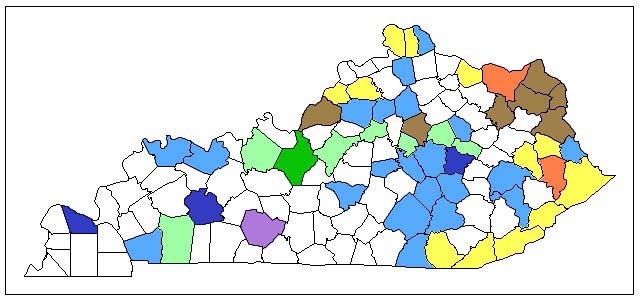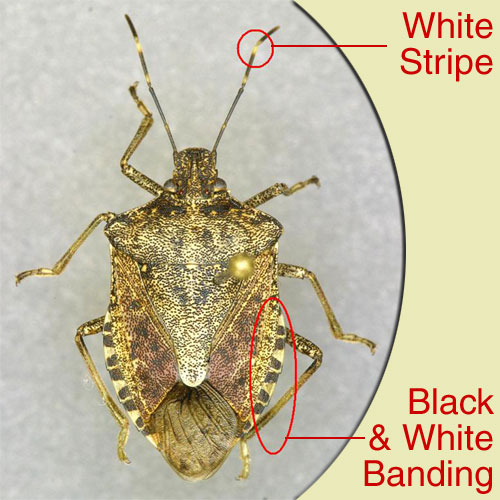Brown Marmorated Stink Bug (BMSB) in Kentucky
This web page contains information about the Brown Marmorated Stink Bug (Halyomorpha halys ) in Kentucky. The first findings were reported in October 2010. If you suspect that this insect is present in an area not marked on the map, please take a sample to your County Cooperative Extension office or sent it to the UK Department of Entomology, S-225 Ag Science North, Lexington, KY 40546-0091.
Counties known to have brown mamorated stink bugs: 2017 (dark blue) Estill, Muhlenberg; 2015 (dark green) Hardin; 2014 (light purple) Warren; 2014 (light green)Anderson, Breckinridge, Christian, Clark, Jessamine, Nelson and Powell; 2013 (blue) - Breathitt, Boyle, Campbell, Daviess, Franklin, Garrard, Grant, Henderson, Jackson, Laurel, McCreary, Madison, Martin, Montgomery, Perry, Pulaski, Rockcastle, Scott, Shelby, Taylor, and Trigg; 2012 (yellow) - Bell, Boone, Harlan, Henry, Johnson, Kenton, Letcher, Magoffin, Mason, Oldham, Pike, and Whitley; 2011 (orange) - Floyd, Lewis; 2010 (brown) - Boyd, Carter, Fayette, Greenup, Jefferson, Lawrence, and Rowan.


(Picture from Rutgers - New Jersey Agricultural Experiment Station)
The brown marmorated stink bug has the characteristic shield-shaped stink bug body. The adults (with wings) are approximately 5/8 inch long with a mottled brown-grey body. The next to last (4th) segment of each antenna has a white band. Edges of the abdominal segments that extend laterally from under the wings are alternatively banded with black and white. The underside of the body is white to light gray with grey or black markings, and the legs are brown with faint white bands.
BMSB Look-Alikes
These brown bugs can show up at homes and structures (left to right - leaf footed bug, spined soldier bug, and brown stink bug). The leaf footed bug has distinct flat areas on the hind legs. The brown stink bug does not have expanded edges of the abdomen with black and white bands. The spined soldier bug has a distinct sharp spine on each "shoulder" and a short dark band on the wing tips that extend beyond the end of the abdomen.

Potential Impact in Kentucky
- Fall Accidental Invader - The BMSB ultimately can cause pose problems for all Kentuckians, similar to that of the multicolored Asian lady beetle, a familiar fall sight in many homes and buildngs. Adults are attracted to homes and structures in the fall as they move to protected overwintering sites. Large numbers may enter through cracks and crevices. These insects produce a stain and unpleasant order when mashed. They will leave protected sites in the spring to resume their life cycle.
- Plant damage - BMSB feeds on the sap of a wide range of plants including fruits, vegetables, ornamentals, and some field crops. Significant losses to the insect have been reported from apple and peach orchards, blackberry, field and sweet corn, tomatoes, lima beans, and green peppers from other states.
Management For BMSB In Homes and Structures
Before Stink Bugs Enter a Building
Mechanical exclusion is the best method to keep stink bugs from entering. Cracks around windows, doors, siding, utility pipes, behind chimneys, and underneath the wood fascia and other openings should be sealed with good quality silicone or silicone-latex caulk. Damaged screens on doors and windows should be repaired or replaced.
Exterior applications of insecticides, may offer some minor relief from infestations where the task of completely sealing the exterior is difficult or impossible. Homeowner products containing the active ingredients deltamethrin, cyfluthrin, lambda-cyhalothrin, cypermethrin, or permethrin are options. They should be applied in the fall as the bugs begin to congregate. These insecticides are broken down by sunlight so the residual effect will decrease and may not kill the insects much beyond several days or a week.
After Stink Bugs Enter a Building
If numerous bugs are entering the living areas of the home, attempt to locate the openings where the insects gain access. Typically, stink bugs will emerge from cracks under or behind baseboards, around window and door trim, and around exhaust fans or lights in ceilings. Seal these openings with caulk or other suitable materials to prevent the insects from crawling out. Both live and dead stink bugs can be removed from interior areas with the aid of a vacuum cleaner - however, the vacuum may acquire the smell of stink bugs for a period of time.
It is not advisable to use an insecticide inside after the insects have gained access to the wall voids or attic areas. Although insecticidal dust treatments to these voids may kill hundreds of bugs, there is the possibility that carpet beetles will feed on the dead stink bugs and subsequently attack woolens, stored dry goods or other natural products in the home. Although aerosol-type pyrethrum foggers will kill stink bugs that have amassed on ceilings and walls in living areas, it will not prevent more of the insects from emerging shortly after the room is aerated. For this reason use of these materials is not considered a good solution to long-term management of the problem. Spray insecticides, directed into cracks and crevices, will not prevent the bugs from emerging and is not a viable or recommended treatment.
Brief History in US
The BMSB, native to China, Japan, Korea, and Taiwan, was first collected in September 1998 in Allentown, PA but is suspected to have arrived several years earlier. It is an agriculturial pest in that area. It has been detected in localities in California, Connecticut, Delaware, Florida, Kentucky, Maine, Maryland, Massachusetts, Mississippi, Missouri, New Hampshire, New Jersey, New York, North Carolina, Ohio, Oregon, Pennsylvania, Rhode Island, South Carolina, Tennessee, Virginia, Washington, D.C. and West Virginia
The BMSB is not a regulated pest so there is no quarantine program to limit its movement.
(Modified from information written by Steve Jacobs, Senior Extension Associate, Pennsylvania State Univ.)
